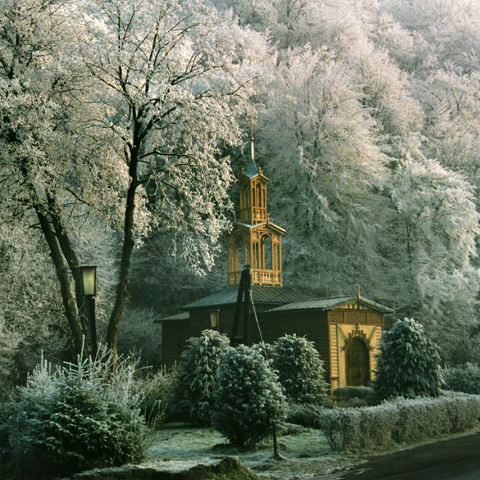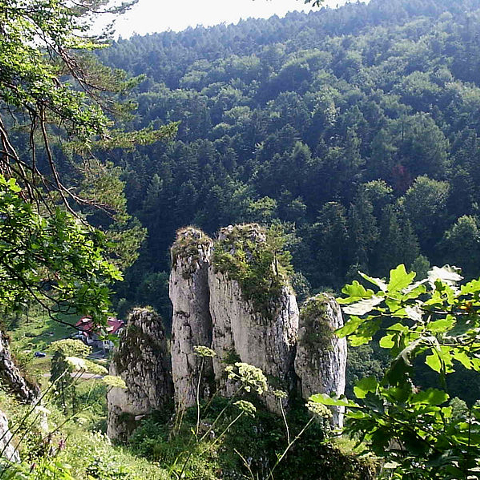Composers / Fryderyk Chopin / Places catalog
Ojców
During a trip from Warsaw to Vienna in the summer of 1829, Chopin and his friends spent a few days in Krakow. While there, they visited several nearby places, including Ojców, which is approx. 24 km from Krakow. The village was initially called Osada nad Prądnikiem and was later renamed after the castle. Casimir III the Great (1310–1370) honoured the memory of his father Ladislaus I the Elbow-high (1261–1333), who once hid in the valley, by naming the fortress ‘Ociec u Skały’ [Father at the rock]. Over time, the name was shortened to ‘Ociec’ and later ‘Ojców’.
During the nineteenth century, Ojców was popular with painters, poets, and scholars. Julian Ursyn Niemcewicz, Klementyna Hoffmanowa (née Tańska), Stanisław Staszic and Jadwiga Łuszczewska (Deotyma) all visited. The rich history of this place gave rise to many legends. These colourful tales made quite an impression on the young composer, who was most likely planning to visit the Dolina Prądnika [Prądnik valley] and Ojców when he came to Krakow. In any case, he set off on the afternoon of Sunday 26 July 1829.
Chopin was not properly prepared for the trip. He related the whole adventure in a letter he wrote to his family from Vienna:
‘Having passed the city and the beautiful surroundings of Cracow, we ordered our coachman to head straight for Ojców, thinking that Mr Indyk lived there, a peasant who usually puts everyone up for the night, and where Miss Tańska spent the night as well. As misfortune would have it, Mr Indyk lives a mile outside of Ojców, and our coachman, who didn’t know the road well, drove into the Prądnik, a little river, or rather a limpid brook, and it was impossible to find another road, because there were rocks to the right and left. Around 9 o’clock that evening, some two people came upon us stranded as we were and not knowing what to do; taking pity upon us, they undertook to lead us right up to Mr Indyk’s place. We had to go on foot for a good half a mile, on the dew, amongst a multitude of rocks and sharp stones. Often it was necessary to cross the little river on round beams, and this was all in the dark of night. Finally, after many difficulties, poundings and whinings, we dragged ourselves to Mr Indyk’s. He wasn’t expecting guests that late. He gave us a little room under a cliff, in a little house built especially for guests. Izabella!… There, where Miss Tańska had stayed! And so, each of my colleagues undresses and dries himself next to the fire that had been lit in the fireplace by the good Mrs Indykowa. Only I, having sat down in a corner, wet up to my knees, meditate on whether to undress and dry myself, or not; and then I see that Mrs Indykowa is approaching a nearby chamber to get bed linen; inspired by a saving spirit, I follow her, and I see a multitude of woollen Cracow hats on the table. Those hats are double, like sleeping caps. In my desperation, I buy one of them for one zlotys, I cut it in two, I remove my shoes, I wrap the pieces around my feet, and having tied them up tightly, in this way I free myself from catching the inevitable cold. Having approached the fireplace, I had a drink of wine, I laughed with my good companions, and in the meantime Mrs Indykowa made our beds on the ground, where we slept through the night splendidly’.
We find more about ‘Indyk’ in a book by Ambroży Grabowski published a few years earlier entitled Historyczny opis miasta Krakowa i iego okolic [A historical description of Krakow and the surrounding area]: ‘It should be added, for the benefit of outsiders, that it is best to visit these areas with a light equipage [horse-drawn carriage]. In the Ojców Valley, however, there lives a peasant farmer by name of Antoni Jędyka, who takes in and puts up travellers and whose cottage has creature comforts not easily found elsewhere’.
Chopin would certainly have seen the famous late-fourteenth-century castle, or rather its ruins, when he visited Ojców. In 1787, the then owners of the area, the Załuskis, treated King Stanislaus Augustus to dinner at the castle. The building gradually fell into ruin. By 1811, Julian Ursyn Niemcewicz (1758–1841) considered it virtually deserted. In 1829, Konstanty Wolicki purchased Ojców from the Russian government. The new owner ordered the demolition of the castle walls, which were threatening to collapse, but left the octagonal tower, defensive walls and entrance gate. A small hall houses an exhibition of the castle’s history.
There are some 400 caves in the predominantly limestone Prądnik Valley. Chopin visited the Czarna [Black] Cave and the Królewska [Royal] Cave (now the Łokieta [Elbow-high] Cave), which is associated with the legend of Ladislaus I the Elbow-high. Legend has it that Ladislaus took refuge there while fleeing the army of the Czech King Wenceslaus II (1271–1305). His pursuers assumed the cave was empty, as a spider had covered the entrance with its web, and so they did not search it.
In 1956, Ojców National Park was created, on account of the exceptional beauty and the geological, biological and archaeological qualities of the Prądnik Valley (known as the ‘Polish Switzerland’). Walking, cycling and horse riding trails have been laid out. The Nature Exhibition in the Park’s Museum and Educational Centre (formerly the Władysław Szafer Nature Museum) has a large and varied collection of Prądnik Valley exhibits and is definitely worth seeing. This was the country’s sixth national park, and its headquarters is in Ojców.
Not far from the former Hotel pod Łokietkiem [Elbow-high hotel] that houses the exhibition is the Hotel pod Kazimierzem [Casimir Hotel]. This building dates from the second half of the nineteenth century.
-

Chapel on the water. Phot. Marek Opalski.
-
.jpg)
Dolina Prądnika. Fot. Jerzy Opioła. (creative commons)
-

White Hand Rock. Fot. Jan Jerszyński. (creative commons)